 Overview
Overview
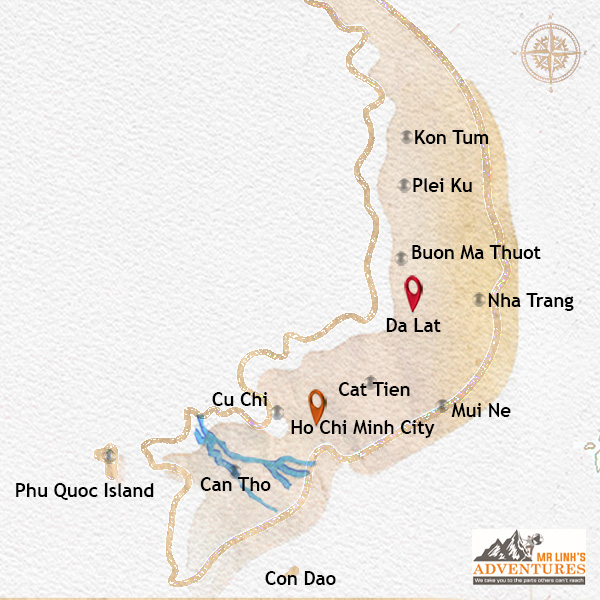
Nestled in the heart of the mountains of central Vietnam,
Da Lat is a charming and picturesque city that attracts visitors with its cool and pleasant climate, green landscapes, and rich history.
Nicknamed the "City of Eternal Spring" or even the "City of Lovers," Da Lat is famous for its beautiful flower gardens, refreshing waterfalls, and French colonial architecture.
 Top Attractions
Top Attractions
Da Lat is a captivating city with a unique blend of attractions. Here are some of its must-see destinations.
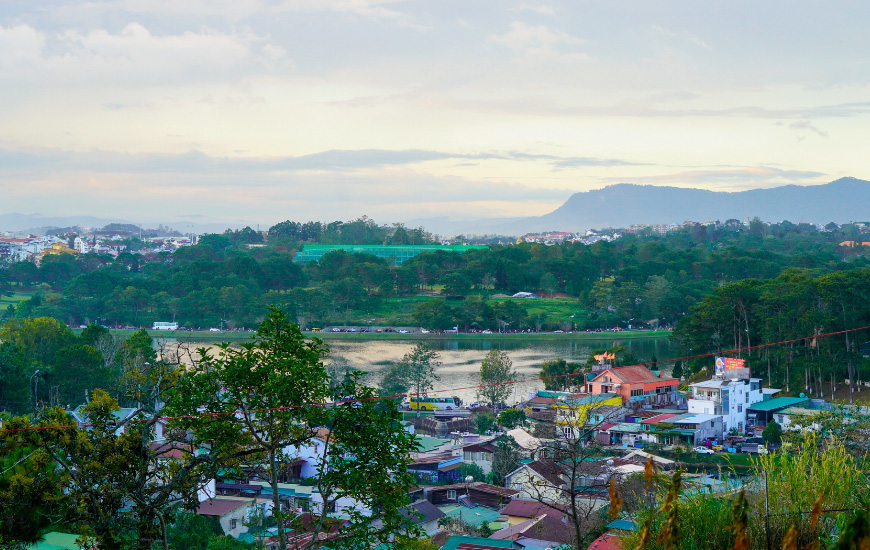 A bird’s-eye view of Da Lat’s enchanting scenery - Mr Linh's Adventures
A bird’s-eye view of Da Lat’s enchanting scenery - Mr Linh's AdventuresXuan Huong Lake
The serene and iconic Xuan Huong Lake lies at the heart of Da Lat, inviting visitors to enjoy leisurely strolls along its picturesque shores, embark on romantic boat rides, or simply bask in the tranquil beauty of its panoramic views.
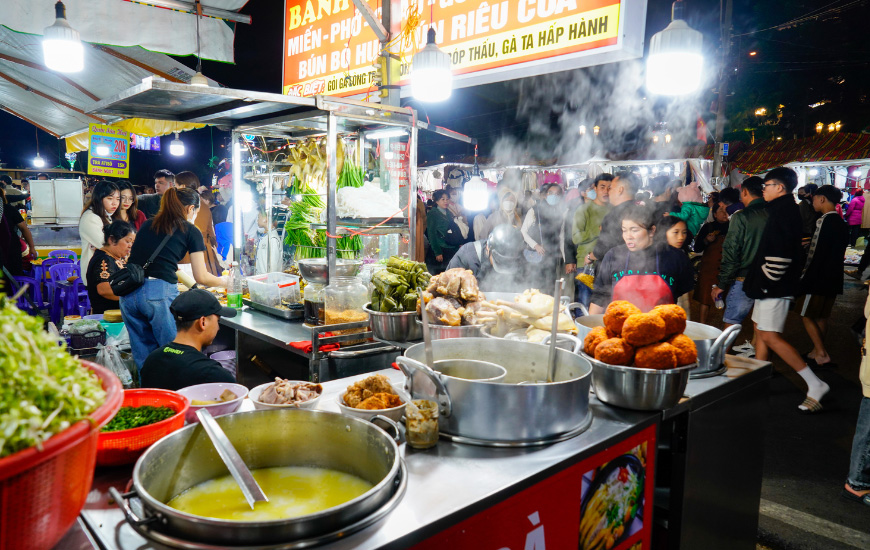 Dalat market by night - Mr Linh's Adventures
Dalat market by night - Mr Linh's AdventuresDa Lat Market
A vibrant hub of local life, the Da Lat Market offers a sensory feast, showcasing a rich array of regional produce, including fresh fruits, vibrant flowers, and handcrafted treasures, while serving as a beloved gathering place for residents.
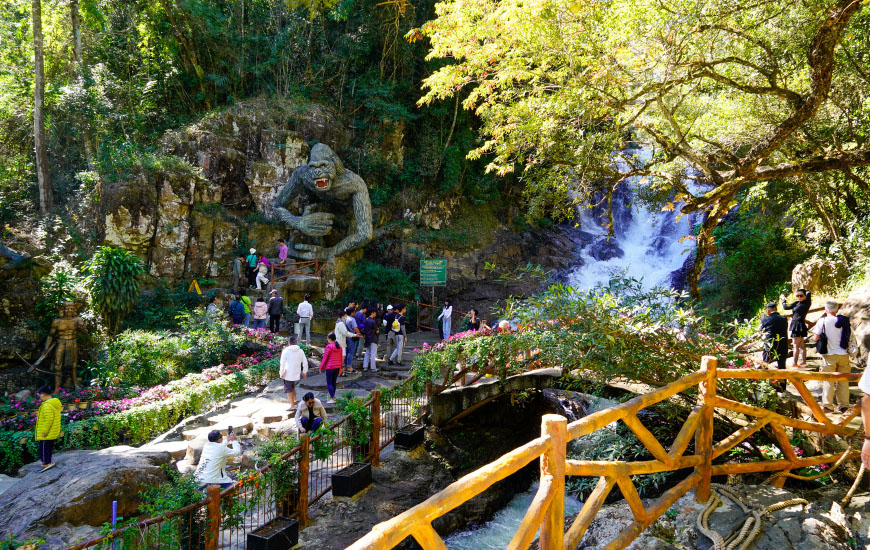 Dantala waterfalls, a popular destination at the gates of Dalat-city - Mr Linh's Adventures
Dantala waterfalls, a popular destination at the gates of Dalat-city - Mr Linh's AdventuresDatanla Waterfall
The majestic Datanla Waterfall, a jewel of the region, captivates with its dramatic cascades, offering adventurous souls the thrill of rappelling or the serene pleasure of admiring its powerful beauty from scenic vantage points.
Bao Dai's Summer Palace
Step into the past at Bao Dai's Summer Palace, the former retreat of Vietnam's last emperor, where visitors can explore the opulent rooms and gain insight into the fascinating history of the imperial era.
 See & Do
See & Do
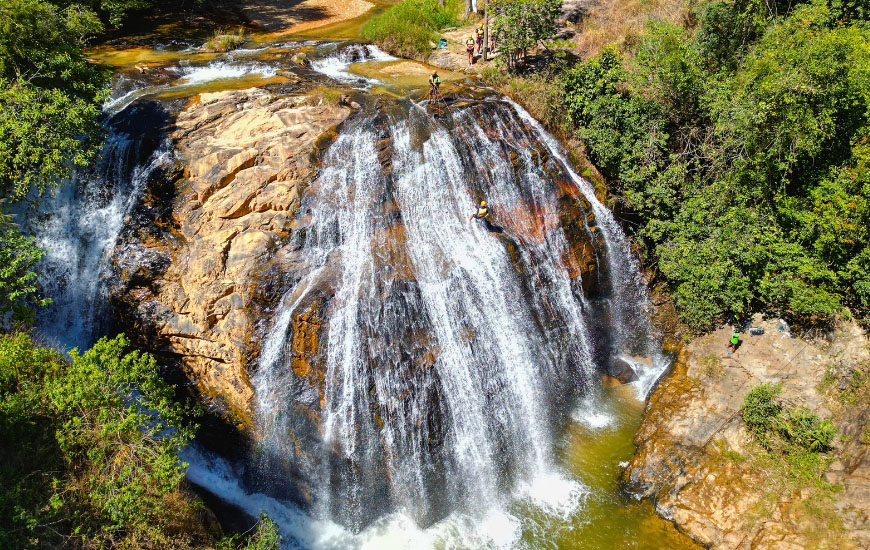
Canyoning Adventure at Datanla Falls - Mr Linh's Adventures
Da Lat offers a multitude of activities for all tastes. Nature lovers can hike in the surrounding mountains, explore the pine forests, or cool off in the many waterfalls. Culture enthusiasts can visit Buddhist temples, pagodas, and traditional villages. The more adventurous can try canyoning, zip-lining, or mountain biking.
 Gearing Up for Canyoning at Datanla Falls - Mr Linh's Adventures
Gearing Up for Canyoning at Datanla Falls - Mr Linh's AdventuresThe Dantala Falls
The Datanla Falls, located just 6 km from Da Lat, are the closest to the city. They offer a small picturesque waterfall as well as fun tourist activities. Visitors can choose to go down the falls to the river, either on foot or by sled on rails. The waters tumble over the rocks amidst lush green forests. According to local folklore of the K'Ho minority ethnic community, fairies used to bathe in these waters.
Further away from the city, at the foot of a mountain pass, is a larger and less developed waterfall: Elephant Falls. By far the most spectacular in the region, it is located at the foot of a magnificent rock formation. The gushing wall of water spills over the curved cliff, onto the mossy rocks, and into the river below. A rudimentary staircase carved into the rock face allows you to descend to the foot of the waterfall, where you can appreciate its power. Below, visitors can contemplate the power and beauty of nature while enjoying a coffee made from locally grown Arabica beans. The more adventurous can even weave through the refreshing spray of the waterfall and explore the cave hidden behind it.
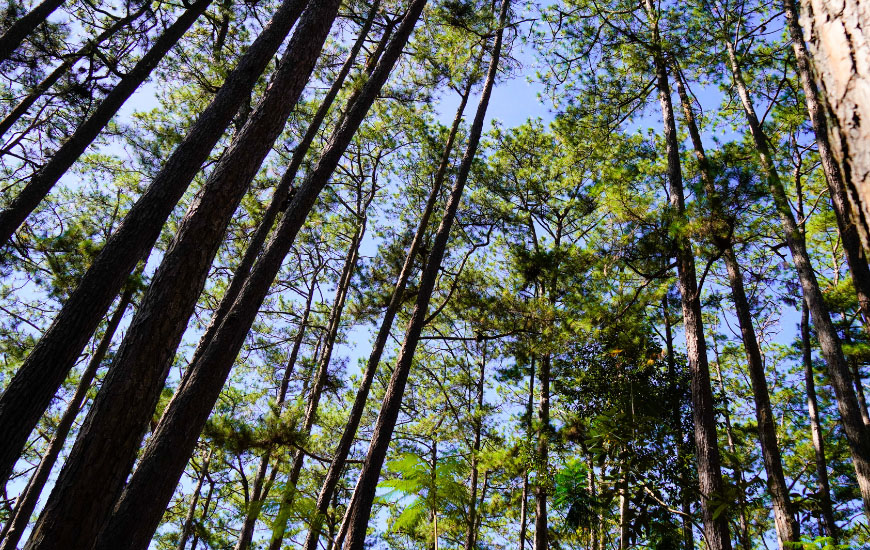 Pine forest in Da Lat - Mr Linh's Adventures
Pine forest in Da Lat - Mr Linh's AdventuresBidoup Nui Ba National Park
32 km north of Da Lat is the Bidoup Nui Ba National Park, a dense forest of 70,038 hectares located on a plateau in the magnificent Langbiang Mountains. It is covered with thick forests of evergreen and coniferous trees, as well as tall bamboo groves. The high altitude and cool climate create a unique ecosystem that is home to many different species of flora and fauna. Rare and fascinating species can be found here, such as the yellow-cheeked gibbon, the Asian black bear, and the vampire flying frog. The park also has 62 rare plant species and more than 250 species of orchids.
The park is crisscrossed with trails that wind through the wilderness. There are many different trails that cater to all levels and abilities, ranging from a gentle afternoon stroll to more vigorous multi-day hikes. The park emphasizes ecotourism and conservation, and the visitor center is an excellent source of information. In addition to offering trekking routes, it provides a wealth of knowledge about the culture and traditions of the K'Ho mountain tribe.
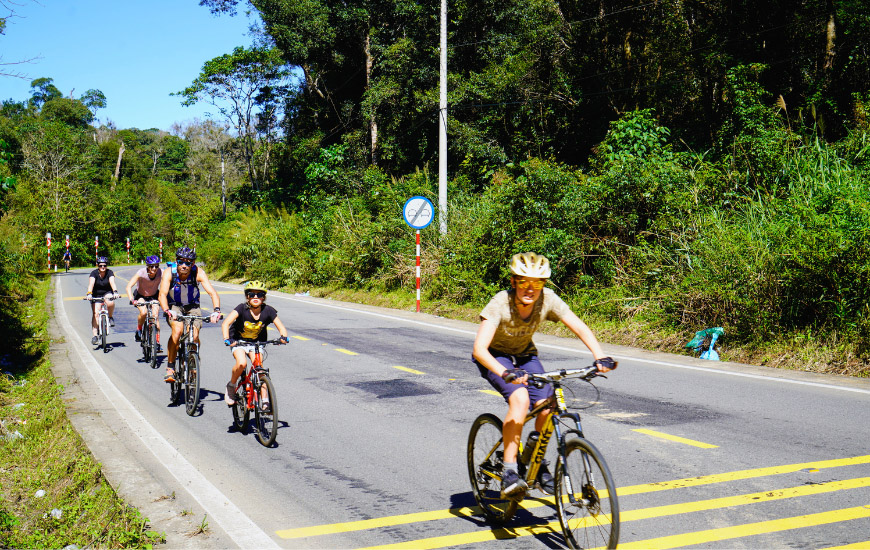 Biking around Dalat - Mr Linh's Adventures
Biking around Dalat - Mr Linh's Adventures
Da Lat also offers fantastic outdoor adventure activities, which are all the more enjoyable in its temperate climate.
Mountain biking is a popular activity, with trails that wind through thick pine forests and single-track paths. This thrill-filled adventure is a great way to travel, speeding through varied landscapes: farms stretching for hectares, dense forests, and rushing rivers. It is also a unique opportunity to meet local ethnic communities, taking the time to discover the traditional villages scattered throughout the region.
Canyoning is another thrill sport that has gained popularity in recent years. It combines hiking, rappelling, and swimming in the beautiful canyons and waterfalls of Da Lat. While this activity is not for the faint of heart, it offers an excellent way to enjoy the beauty of the surrounding nature.

Trekking through Da Lat’s lush countryside - Mr Linh's Adventures
Exploring the surrounding villages
Away from the city, in the green countryside, are the flower villages, each specializing in the cultivation of many different species.
Van Thanh village is one of the largest flower villages in Da Lat and specializes in growing many varieties of roses. The large greenhouses are filled with rows of delicate flowers, each lovingly cared for by the farmers.
Ha Dong Flower Market is considered the first flower market in Da Lat and mainly cultivates indigenous Vietnamese species. Over the years, the technology available to farmers has become more complex and now allows them to grow many more varieties than before.
Ethnic villages
Lat village, located north of Da Lat, is home to the Lat hill tribes, who gave Da Lat its name. The group of hamlets is located at the foot of Langbiang Mountain and consists of traditional stilt houses.
The villages are full of life, with women weaving on their looms and children running between the wooden stilts.1 In addition to the Lat minority ethnic community, Lat village is also home to the Chill, Ma, and K'ho tribes. After discovering the rich culture of the local communities, visitors2 can go to the top of Langbiang Mountain. From the summit, there are amazing panoramic views of the typical pine-covered countryside below.
Lanh Dinh An, a hamlet in Lat village, combines local culture and strange art. Known as the "Chicken Village," its main attraction is a huge concrete rooster perched on top of a block of concrete. The rooster seems to be in full song, calling the villagers.
Lanh Dinh An is also a great place to meet the locals and learn about their culture. The women of the village spend their time sitting at their large looms, creating intricate pieces of fabric that are then sold as scarves and bags in souvenir shops.
 Go Green
Go Green
For an unforgettable experience, Mr Linh's Adventures offers unique tours in the Da Lat region. Discover the spectacular landscapes, authentic villages, and local culture during our hikes, treks, and bike tours. Our experienced guides will share their passion for the region and provide you with unforgettable moments.
 Heritage
Heritage
The cool and pleasant climate of Da Lat explains why the French began to develop the region in the 1890s. Seeking to escape the stifling heat of the south, the French bacteriologist Alexandre Yersin proposed to establish a hill station in the neighboring town of Dankia. However, it was Da Lat that was ultimately chosen on the recommendation of Etienne Tardiff, and construction began in the early 1900s.
Ernest Hébrard set out to design a true "home away from home," drawing heavily on French architecture to endow the city with European-style villas, hotels, and boulevards, many of which still exist today.
Miraculously spared from the ravages of war (with the exception of its involvement in the Tet Offensive), Da Lat has retained much of its charm and French-influenced architecture. Over time, Vietnamese culture has naturally integrated and enriched its identity.
Today, this unique blend of European charm and Vietnamese "kitsch" makes Da Lat a city apart, a place where history and culture meet and mingle with an endearing originality.
This unique blend of European charm and Vietnamese "kitsch" attracts domestic tourists, and especially newlyweds, as Da Lat is considered the honeymoon capital of Vietnam.
While the city center has modernized, the surrounding areas retain a European charm with their picturesque cafes and small boutiques. The landscapes that border the city are just as captivating, with their pine forests, rolling peaks, and peaceful lakes. The rural areas are home to magnificent flower gardens, renowned coffee plantations, and agricultural land.
The cool climate and vast expanses of countryside make Da Lat an ideal place for outdoor activities, and there is no shortage of options.
Da Lat Railway Station, a magnificent vestige of the colonial era, is a vibrant tribute to the Art Deco style. Its three-pointed roof, a bright yellow, is pierced with small square windows in stained glass. A Japanese steam locomotive is also on display in the station. Located near the center of Da Lat, the station is an ideal place to admire this unique architecture, or even to take a tour. The original line, which connected Da Lat to Thap Cham, was closed due to damage caused by Viet Cong attacks.
Today, the station only provides a tourist connection with the neighboring town of Trai Mat. This line crosses the green and picturesque landscapes of Da Lat, offering a pleasant way to admire the region.
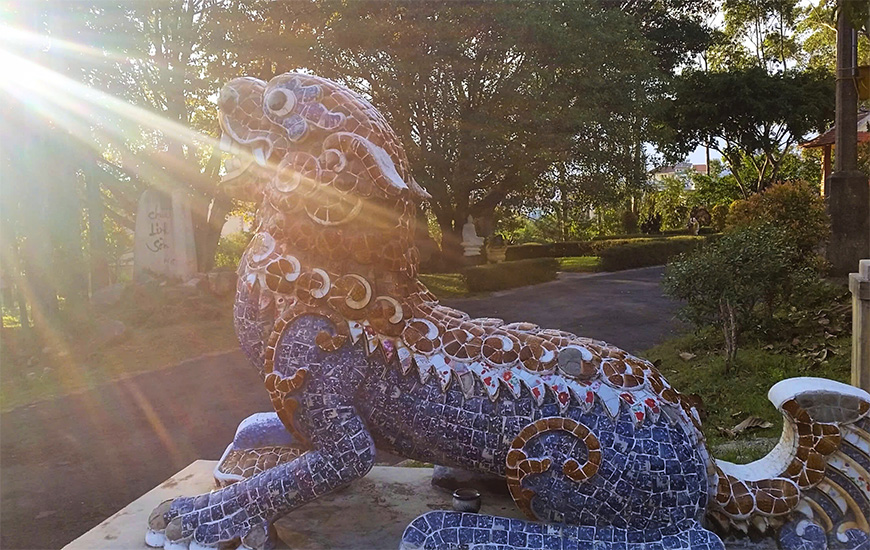 Linh Phuoc pagoda, high spiritual place in Dalat - Mr Linh's Adventures Team
Linh Phuoc pagoda, high spiritual place in Dalat - Mr Linh's Adventures Team
Once you arrive in Trai Mat, visitors can admire the Linh Phuoc Pagoda, with its intricate patterns and majestic mosaic dragon.
The Bao Dai Summer Palace is another testimony to the Art Deco heritage left by the colonial era.
Behind its rather sober exterior lies the immaculate summer residence of the last emperor of Vietnam.
The palace was built near a pine forest to allow Bao Dai and his family to escape during the hot summer months. Built between 1933 and 1937, it was used by the imperial family until 1950. Designed in the Art Deco style, then in vogue in France, the palace reflects the Francophilia of Bao Dai, who had studied at some of the most prestigious institutions in France and where he later died, after living many years in exile. Inside, visitors can stroll through the rooms, all furnished with period furniture, and get a glimpse into the life of Vietnamese royalty. The collection of family photos hanging on the wall is particularly revealing.
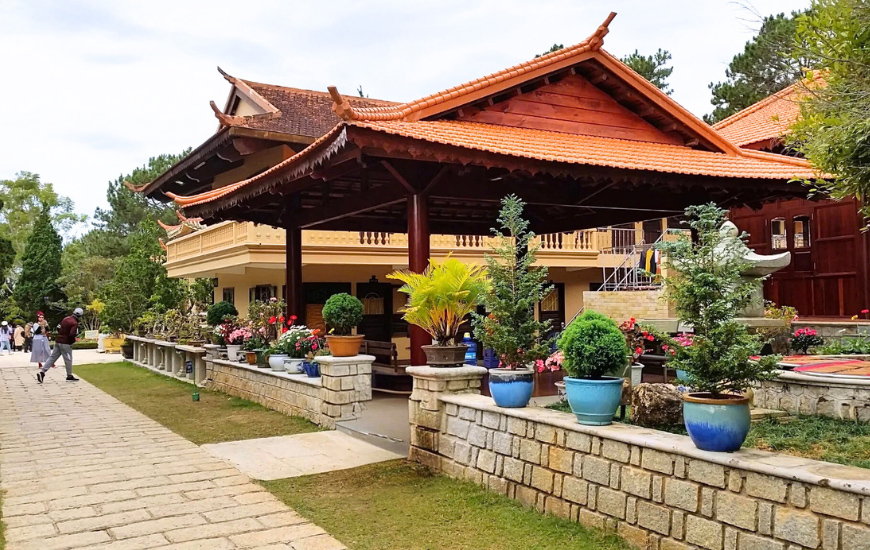 Lam Truc Zen Temple - Mr Linh's Adventures Team
Lam Truc Zen Temple - Mr Linh's Adventures Team
A little further from the city, in the heart of the green countryside, is the Truc Lam Temple. Access to the monastery and temple is via a two-and-a-half kilometer cable car that transports visitors over the pine-covered hills. The aerial view highlights the unique flora of Da Lat.
The temple is dedicated to the revival of Zen Buddhism and houses about a hundred Buddhist monks and nuns. Zen Buddhism emphasizes the importance of meditation, and the fresh mountain air, peaceful gardens, and serene atmosphere of the temple provide an ideal setting for reflection.
 Food & Drinks
Food & Drinks
 Banh Trang Da Lat, one of the local specialties - Mr Linh's Adventures
Banh Trang Da Lat, one of the local specialties - Mr Linh's Adventures
Da Lat's exceptionally cool temperatures offer unique opportunities to grow fruits and vegetables that would not survive in other parts of Vietnam. Here, artichokes, strawberries, and avocados thrive and are used in a number of delicious local specialties. One of the sweet treats that takes advantage of the fruits grown here is ice cream made from fresh avocados and strawberries.
Coffee cultivation is another thriving food industry in Da Lat, with plantations scattered throughout the region. The many farms that cultivate rich Arabica beans offer an excellent insight into the long process that goes from seed to bean and then to cup. The rich, aromatic coffee made from these fresh beans is served in Da Lat's many charming cafes and is the perfect pick-me-up in cool weather.
A more unusual product of Da Lat is the locally produced wine, known as Vang Dalat. Unlike the rest of the alcohol produced in Vietnam, this wine is European in style. Made from a blend of grapes from the neighboring town of Phan Rang, mulberries, and strawberries, the company produces a range of different varieties that are sold domestically and1 abroad. The techniques used for winemaking aim to produce a European-style wine that is both affordable and delicious.
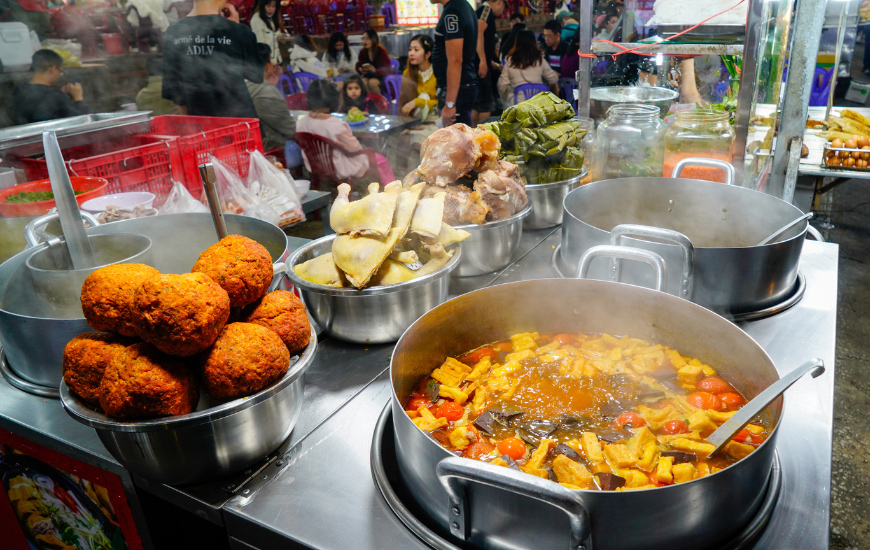
Street food at night market - Mr Linh's Adventures
Da Lat cuisine is a blend of Vietnamese and French flavors. Local specialties include Banh Trang Dalat, a delicious snack that can be enjoyed hot over tiny charcoal fires along the roads. Thin, round sheets of rice paper are heated on the grill and topped with a mixture of spring onions, eggs, and shrimp. Once the egg mixture has formed a soft, fluffy omelet, the whole thing is rolled up and served with a spicy and sweet sauce. This warm and comforting snack is a great way to warm up during the cooler months.
Banh Can is another delicious street food dish, which can be found in many stalls or small restaurants. These light and fluffy rice flour pancakes are filled with delicate quail eggs and sprinkled with freshly chopped spring onions. In addition to their fantastic taste, it is fascinating to watch the vendors cook the banh can in small circular molds. The molds are filled with pieces of cake and egg and covered with a small lid until they puff up and become delicious bites.
 Directions
Directions
Location
Da Lat is located about 300 km from Ho Chi Minh City and 1,500 km from Hanoi.
How to get there
There are several ways to get to Da Lat from Hanoi:
Plane: Vietnam Airlines and Vietjet Air offer direct flights from Hanoi to Da Lat. The price of a round-trip ticket varies between 100 and 200 USD.
Bus: Many buses connect Hanoi to Da Lat. The journey takes about 30 hours and costs between 30 and 50 USD.
Best season
The best time to visit Da Lat is from March to May and from September to November, when the weather is mild and dry.
Come and discover Da Lat, a unique and endearing city that will not fail to seduce you with its natural beauty, cultural richness, and warm atmosphere!